While at the top of the South Island, there was one place I was absolutely determined to visit. So Dad and I embarked on a pilgrimage to the place where Māori and European first met – where Dutchman Abel Tasman encountered the warriors of Ngati Tumatakokiri. We know from Tasman’s log that it ended badly, but what happened to the other side of the story?
First of all, we would need to get there – no mean feat after ex-cyclone Gita had done a number on the only road in and out of the Golden Bay region. I followed the advice of my Nelson contact and scheduled the trip for a Sunday, the only day of the week on which the road would be open for more than a few hours. My adventure was therefore scheduled to begin after 7am and conclude before 5pm, lest I find myself stuck in Golden Bay overnight.
We were lucky enough to score prime position at the front of the queue waiting for access over the hill. It was a twenty minute wait for traffic coming in the opposite direction before the pilot vehicle arrived to lead us over the perilous road. Indeed the ravaged road did require careful attention, with many washouts and pitfalls along the way.
Finally we made it past the damaged section and were able to drive normally once again. We continued north, and north some more until we finally hit the coast at Pohara beach.

The winding coastal road hugged the base of pale limestone cliffs. Lush foliage clung on anywhere a root-hold could be gleaned, and tree ferns leaned out into the light. Passing the marina brought us through a short tunnel under the bluff and in view of the sign post directing us to the Abel Tasman monument.
We pulled off the road and headed up the short path to the platform that supported the monument, a gleaming white obelisk overlooking Ligar Bay.

This monument was erected in 1942, commemorating the 300th anniversary of Abel Tasman’s visit, and is one of 13 designated national monuments in New Zealand. Funnily enough, it’s the first one I’ve visited (most are in the North Island), but I have visited one of the overseas ones – in Le Quesnoy!
The bay below is quite lovely, but we considered it odd that the monument was placed here, as Abel Tasman’s actual position when the famous meeting occurred was closer to Wainui Inlet, which we had not quite reached. So it was back into the vehicle to continue our journey.
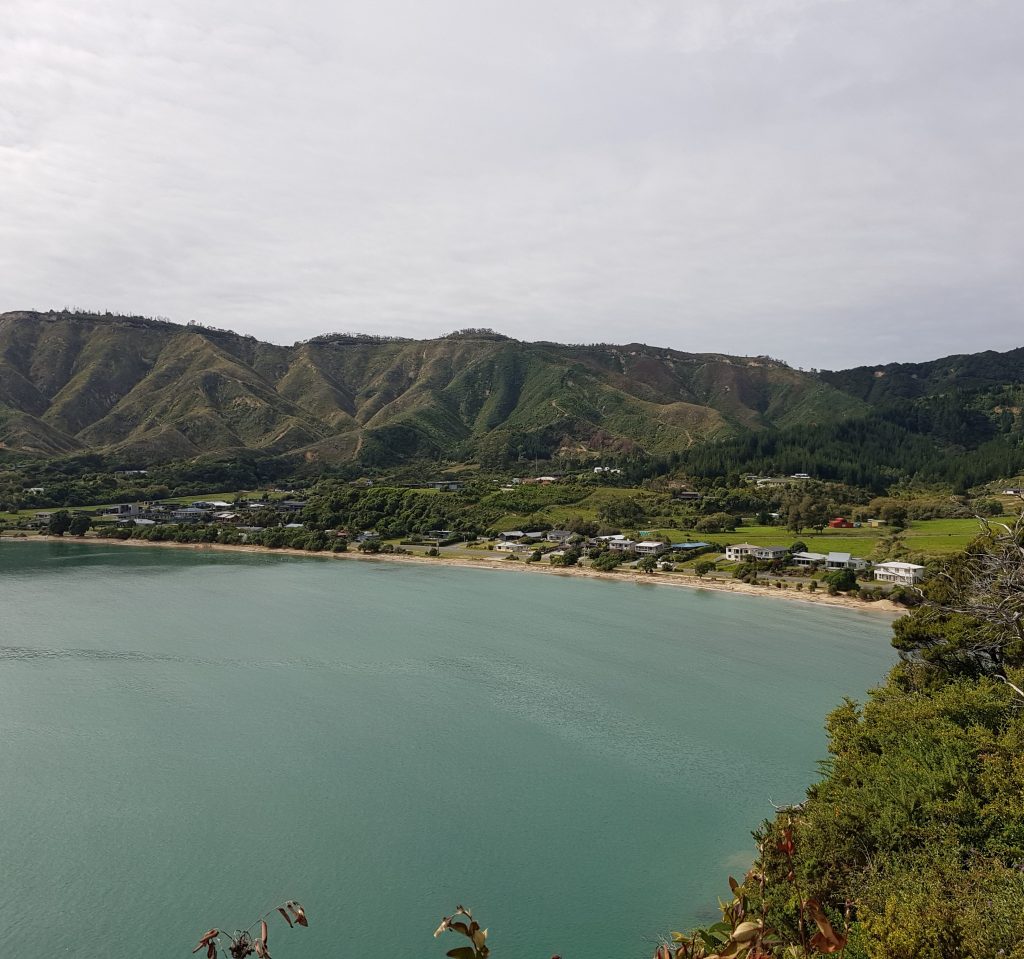
I would have liked to get some pictures looking down on the inlet as we chugged over the bluff, but unfortunately there were no decent vantage points. The best I could get was a partially-obscured peek through the greenery, where I could only just make out the sand bar that guards the entrance to the sheltered Wainui Inlet.
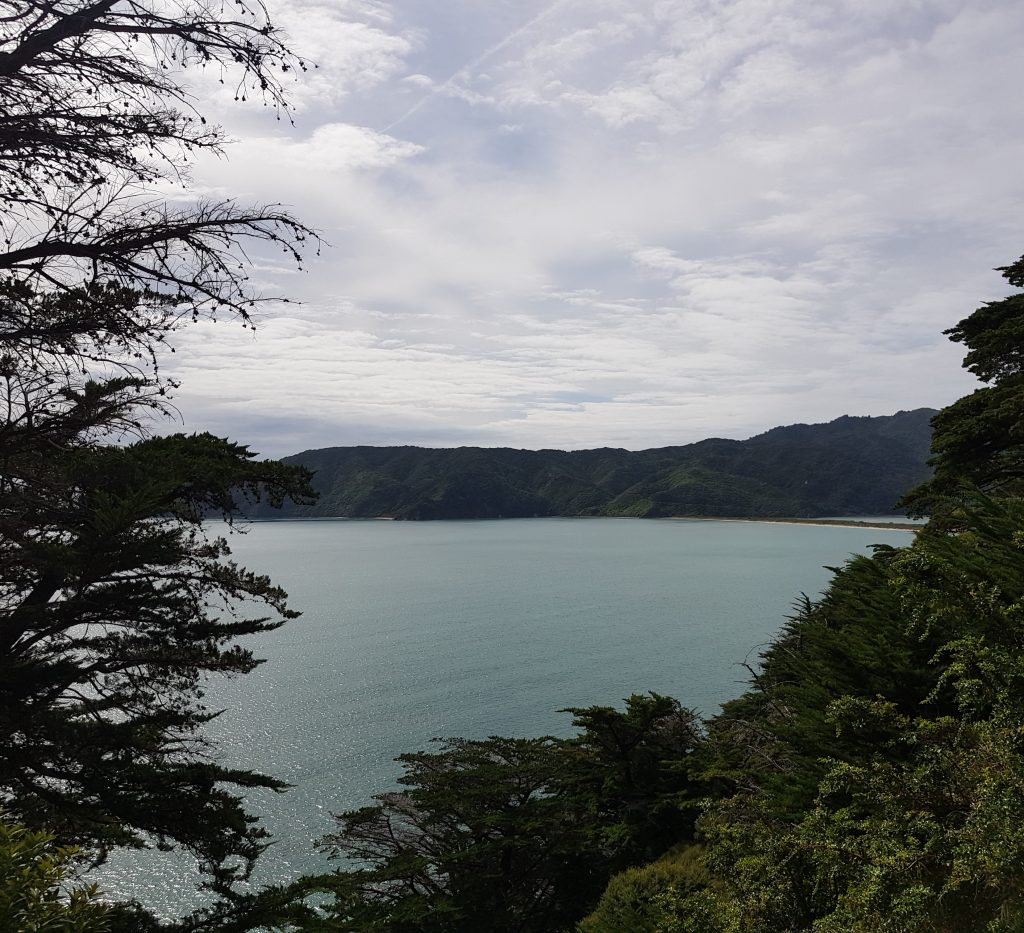
In some Maori traditions this inlet the lair of Ngarara Huarau, a fearsome lizardlike taniwha who once preyed on travellers passing by the entrance to his cave here. He captured a woman named Ruru to serve as his wife, but she was able to convince him to let her leave the cave as long as she stayed tied to a length flax rope. Ngarara Huarau would tug every so often on the rope to ensure she was still there.
As soon as she was out of the taniwha’s sight, Ruru tied the rope to a springy tree and fled home to her family. They put together a plan and invited their monstrous in-law to dine with them, enticing him into a house specially built for the occasion. While Ngarara Huarau enjoyed a pre-meal nap, Ruru’s family were busy piling brushwood around the outside of the house before setting it alight. With long spears they stabbed at the stricken beast, and as their victim thrashed about his tail broke off (as happens sometimes with lizards) and landed in a pool beneath the Wainui Falls – thus it is the taniwha’s blood that stains the river red-brown.
Another day I might have searched for Ngarara Huarau’s cave, or for the rock that the poor maiden was tethered to, which is said to still bear a mark where the rope rubbed against it. But we are not here today to trifle with taniwha – we are on the trail of a much more recent story.
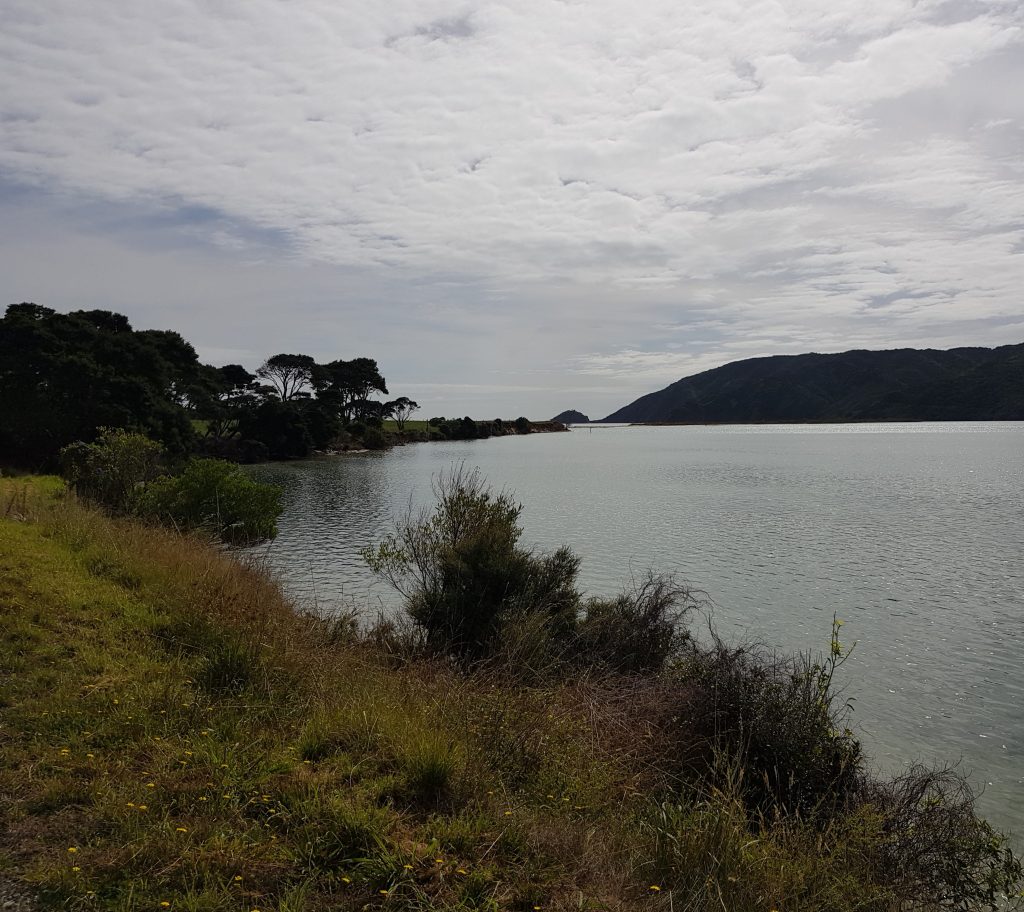
We made our way to the start of the advertised bay walk only to discover that it was under water! I hadn’t thought that I might need to time my visit with the low tide as well as with the road access. So instead I stood at on the shore of the bay and tried to imagine how Abel Tasman’s two ships, the Heemskerck and Zeehaen, might have looked to somebody standing on shore that fateful day in 1642.
While sailing up the West Coast Tasman had already noticed signs of habitation on shore, and in hindsight the smoke he’d been spotting may well have been from a series of signal fires raising the alarm at the strangers’ approach.
It wasn’t until the boats were moored here that four waka approached the visitors. The passengers were Ngati Tumatakokiri, a tribe that originated in the Bay of Plenty but had migrated to this region in the mid-1500s. At their height, they controlled all of Golden Bay and the West Coast as far south as what is now Greymouth.
The Māori hailed the visiting ships several times using a horn-like instrument and Tasman gave the order for one of his crew members to return the signal on a trumpet. After exchanging calls several times the waka departed.
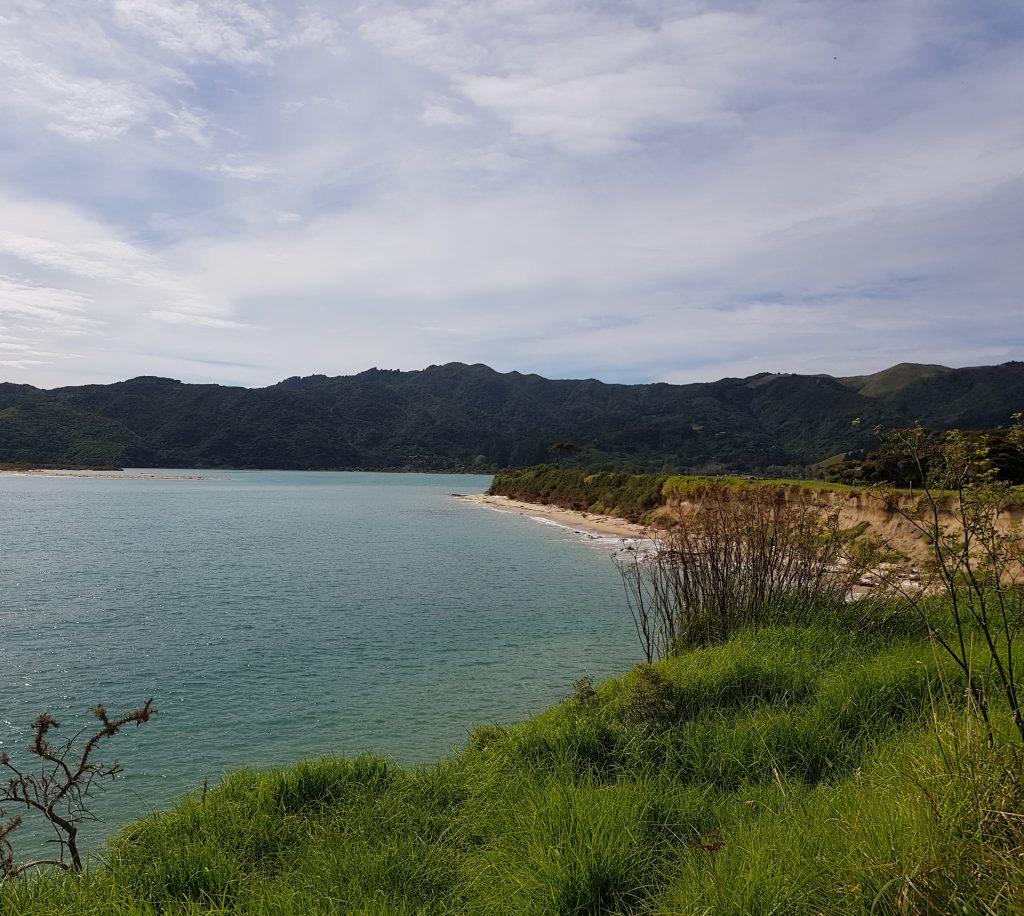
The next morning (19 December) a single canoe returned and the occupants performed a haka, returning to land without responding to the Dutch crew’s attempt to convince them to come aboard for trading purposes. Tasman interpreted the interactions as overtures of friendship and ordered his two ships to be moved closer to shore but scarcely had they begun to carry this out when two more canoes approached while the sailors attempted again to entice them aboard. The captain of Tasman’s second ship, the Heemskerck, decided to send a message of caution to Tasman in the Zeehaen but when the small messenger craft set out to return to the Heemskerck one of the Māori waka made for it with great speed.
The defenceless vessel was capsized and four sailors were killed, though two more managed to swim to safety. The Māori fled, carrying the body of one of the unfortunate sailors with them.
Tasman decided immediately to leave, pursued by several waka. He gave this place the name (in Dutch) Murderer’s Bay, and had no further contact with New Zealand’s native people before leaving the land he had “discovered”.
Here I would usually tell the other side of the story, but in this case there isn’t one. As mentioned earlier, Ngati Tumatakokiri were the resident power in this region for over two hundred years, and their territory included several trails used to source that most valuable of pre-European commodities: pounamu. They were put under pressure by successive waves of migration from the north and from Ngai Tahu in the south and east.
With no allies they could not hold out forever against the many enemies which besieged them and by the early 1800s the tribe had collapsed and essentially ceased to exist. Only a few isolated pockets of settlement and individual slaves remained by the time the next Europeans visited these shores, and their oral history and whakapapa have been almost completely lost.
For this reason we can only speculate on the motive for the attack on Tasman’s men, and it’s possible that the tragedy boiled down to a simple cultural misunderstanding. If you have ever been welcomed on to a marae, you will know that the process is highly ceremonial, with a challenge being issued to the visitors who then must demonstrate their intention to come in peace. In the past this was a way to discover if visitors were friends or enemies. When the Dutchmen responded to the ritual challenge in kind – by blowing their horns, the inhabitants of this bay may well have interpreted it as a declaration of hostility.
Moreover, the situation in Golden Bay was already tense. As I mentioned, Ngati Tumatakokiri were constantly beset by enemies and would have been on their guard against any signs of invasion. This area was always vulnerable, being a hotly contested foothold in the South Island for tribes invading from the north. For these reasons the warriors of Ngati Tumatakokiri may have judged it necessary to make a pre-emptive show of force.
There have also been suggestions that the Māori mistook the visitors for patupaiarehe – mythological fair-skinned fairy folk – or feared that their presence at Wainui Inlet might awaken Ngarara Huarau, though I am hesitant to ascribe to superstition what can be just as well explained by human fallibility.
In any case, the episode was a strange and out of place one in New Zealand history. Though Tasman’s discoveries were added to the canon of European geographical knowledge, it would be over 120 years before another visited our shores. Meanwhile, the legend of his arrival was extinguished in Māori lore, so that Captain Cook’s arrival would have been as much a surprise in 1769 as Tasman’s had been in 1642.
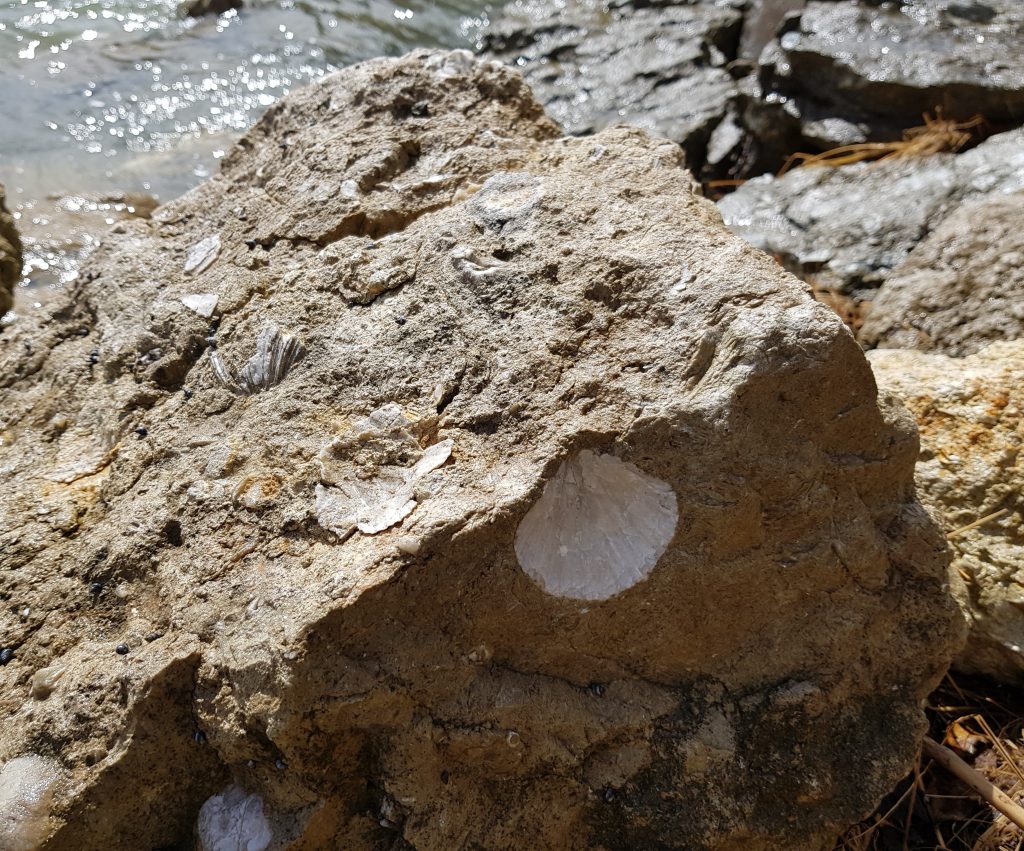
Like Tasman we would leave all too soon, though on much better terms with the locals. Passing Ligar Bay on our way back we had a striking view of the Tasman obelisk standing proud on its outcrop. I have to admit it’s looks pretty good there. Just this once I’ll allow aesthetics to outweigh pedantic accuracy.
We stopped only once more before leaving Golden Bay, to search for beetles and fossils on the shore. Then it was back over the karst and cave-riddled Takaka Hill before curfew and home to our sunny Nelson lodgings.
References:
The first meeting – Abel Tasman and Māori in Golden Bay by Karen Stade
Te Tau Ihu o te Waka: Aa History of Maori of Nelson and Marlborough. Volume I: Te Tangata me Te Whenua – The People and the Land by Hilary and John Mitchell
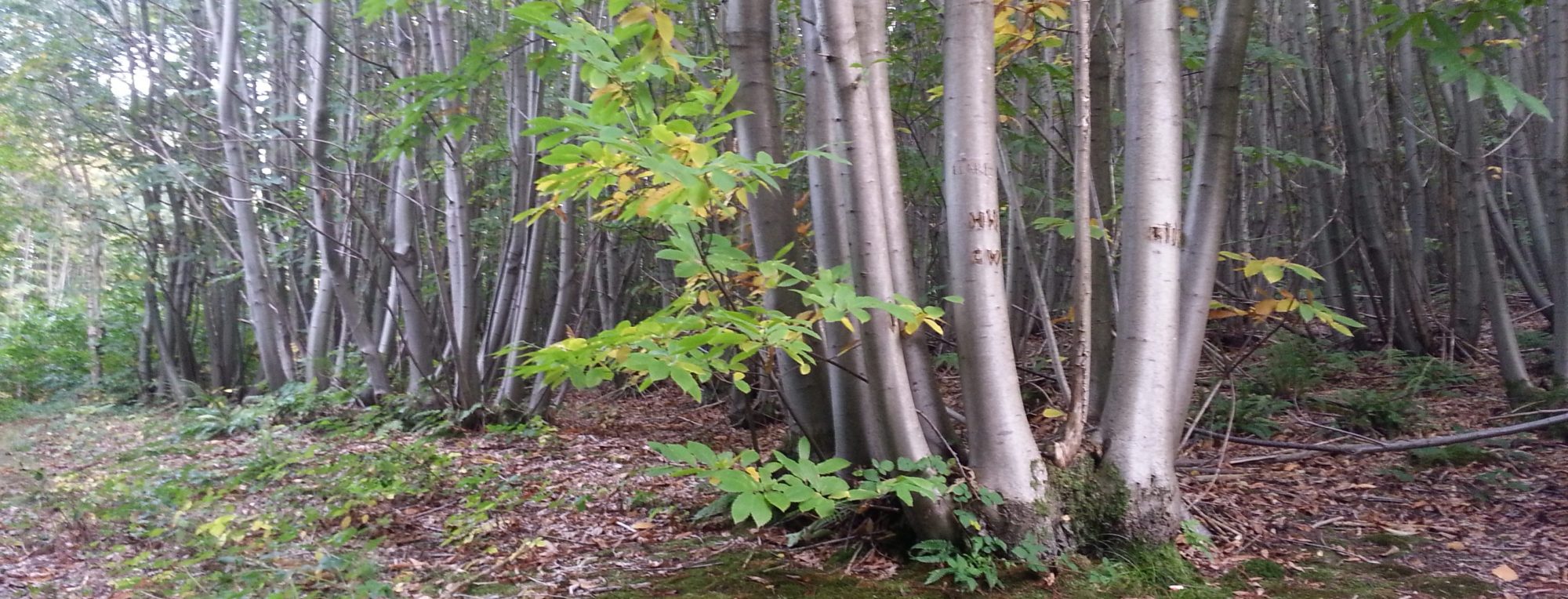

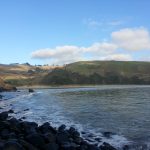
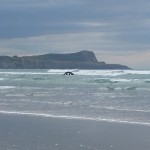
A good yarn, thanks for the info.
Tasman encroached on a tapu fishing area and the ancestors rammed the small boat as a warning. The four who died drowned because they could not swim and we didn’t expect that. Why would someone use a boat if they couldn’t. There was no intention to kill anyone, a warning was the only intention.
Lot of speculation there, drowned ? sailors on a 10 month voyage not being able to swim?, nah!
Eating people esp strange new ones was commonplace , the tribe was wiped out by other tribes killing and eating them , they had every right to be shit scared. Pity they didn’t open time talking with the Dutch as they could of helped them defend themselves.
Such is life in a place with bugger all food ( no pigs , sheep, cow’s other large domesticated animals )
Like the humour here too. In all likelihood Tasman was being greeted and completely ballsed-up the opportunity. Pity. I’ve spoken to representatives of Ngati Tumatakokiri too and by their reckoning dozens of their ancestors were killed when Tasman had both of his ships firing countless rounds of cannon fire and musket fire on at least 2x occasions. They say Tasman’s diary also mentions he waited purposefully until 11x waka were at point blank range before opening-up with withering fire.